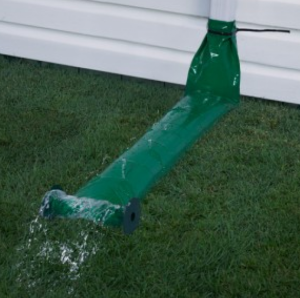 The Rainguard Automatic Downspout Extension is great for people who need a down pipe that is hidden but still takes the water away from the house. We have shown both the old down pipe and the new one. the old one is the beige pipe with the black extension laying on the brick driveway. While it is effective it really does not look very nice and the family often trips over it as they go around the corner of the house.
The Rainguard Automatic Downspout Extension is great for people who need a down pipe that is hidden but still takes the water away from the house. We have shown both the old down pipe and the new one. the old one is the beige pipe with the black extension laying on the brick driveway. While it is effective it really does not look very nice and the family often trips over it as they go around the corner of the house.
The new Rainguard Automatic Downspout Extension is the green coiled device that is coiled up by the vines on the brick driveway. When it rains, this device rolls out and water is carried away from the house. For light rains, there are six small holes which allow the water to leave the coil. In heavy rains, it uncoils the entire distance and there is an opening at the end to allow a heavy flow of water to dissipate well away from the house foundation.
One of the major advantages of this device is that it coils up out of sight when there is no rain. No more stepping over the old downspout! It is also important to mention that water should never be allowed to collect near the foundation. There should always be good drainage to take the water away from the house. Most new homes have weeping tile around the basement of the home. They sometimes get plugged and water then seeps into the basement. Plugged tiles can cause water damage, mold issues and damage to the interior contents of the home.
Rainguard Automatic Downspout Extension – Installation
Installation is very easy. They provide a flexible plastic clamp to use to wrap around the raingurad over the down pipe. You cannot see it in this picture due to the leaves from the vine, However it is very easy to install and no tools are needed for the installation. You might need a screw driver to remove the old down pipe depending on how it is attached. It is extremely easy and does not require any do it yourself difficulty.
Rainguard Automatic Downspout Extension – Remove for the Winter
The instructions do not indicate that you should remove it for the winter. However, we happen to think that it should be removed. If you have freezing weather with lots of snow etc, this device could be damaged by the ice and snow. Our plan is to re-install the old one for the winter and then exchange it again next spring. This is just our opinion and does not reflect the opinions of the manufacturer. There are many small jobs like this one that can easily be accomplished by the homeowner. In this case the rain guard can be used year after year.